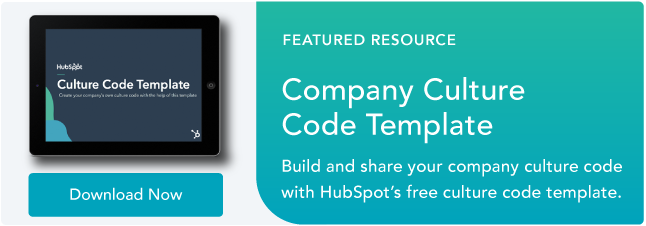A company’s reputation matters more than ever during a job seeker’s search, as 86% of workers would not apply for, or continue to work for, a company with a bad reputation with former employees or the general public.

Ultimately, you spend plenty of time creating a compelling brand story surrounding your products or services, but how do you build a strong employer brand that attracts top talent? Here, we’ll explore what employer branding means, examples of good employer branding, and how you can implement your employer branding strategy today.
Table of Contents:
What Is Employer Branding?
Employer branding is the reputation you have as an employer among your employees and the workforce. It’s also how you market your company to job seekers and internal employees.
The better you are at employer branding, the more likely you are to retain and attract your top talent, as 69% of surveyed employees think it’s extremely/very important that their employer has a brand they’re proud to support.
Let’s say you’ve done a phenomenal job building up a strong brand with your products or services. Unfortunately, that alone won’t convince someone to work at, or stay at, your company. You need to implement the same branding strategy when communicating your company’s leadership, values, and culture.
If a job seeker asks an employee at your company, “What’s it like to work there?” the employee isn’t going to say, “We’ve built some awesome merchandise.” Instead, he’s going to lay into the day-to-day of people management, company values, and workplace culture. To ensure a good employer brand, you need to tell a compelling story.
Employer branding goes deeper than storytelling — you also need to walk the walk. Telling your employees and the general public that having a ping-pong table makes you a great place to work isn’t going to cut it.
Why Is Employer Branding Important?
At this point, you might be wondering, does this really matter to me and my company?
Yes — employer branding is critical to your bottom-line. It can reduce turnover rates and cut your costs per hire in half, helping you save money. Additionally, active job seekers are more likely to apply for a job if the employer actively manages its employer brand.
You have an employer brand whether you’ve put effort behind it or not — so why not put effort in to ensure it’s a brand you can be proud of?
Next, let’s explore how you can implement an employer brand strategy today.
Employer Branding Strategy
An employer branding strategy allows you to control and positively change the dialogue surrounding your company to ensure higher talent acquisition and retention. At its most basic, employer branding is how you market your company to job seekers and what employees say about your company as a workplace.
A good employer branding strategy can help you attract better talent, cut down on hiring costs, and reduce employee turnover.
1. Know your company’s unique value proposition.
A powerful employer brand begins by focusing on your company’s mission statement, values, vision, and culture. It can be helpful to identify what your business needs are and work backward to understand the type of talent you need to fulfill those objectives.
For instance, consider Teach for America’s mission statement — “One day, all children in this nation will have the opportunity to attain an excellent education.”
With this statement, Teach for America can tell a compelling brand employer story on their Values page, where they promise employees the chance for continuous learning, stating, “We operate with curiosity and embrace new ideas to innovate and constantly improve. We take informed risks and learn from successes, setbacks, and each other.”
In this way, they’ve aligned their values, and their employer brand, with their business goal.
2. Conduct an employer brand audit.
You might not be fully aware of your company’s reputation among job seekers, or even your employees.
Conduct a brand audit and send out internal surveys, conduct social media searches, monitor career sites for reviews, or hire a firm that monitors reputations. Your research should help you uncover your employee’s favorite aspects of your company culture that you can focus on highlighting and any areas for improvement to ensure a strong employer brand.
Glassdoor found that brands with above-average or leading employer brands devote time to monitoring employee engagement, take action on employee feedback, and keep an eye on brand health, more than average or below-average employer brands.
3. Write an employer value proposition.
Once you’ve researched, cultivated a list of business values, and learned about your existing perceptions, you’ll want to create an employer value proposition.
An employer value proposition is a marketing message and a promise, so say things that are factually true about your business that your employees would agree with. You can use this value proposition on your website, recruitment materials, or LinkedIn Company Page, and recruiters and HR teams can discuss it with potential candidates.
It’s important to note that your value proposition should have nothing to do with compensation. Instead, you want it to evoke passion in employees and potential candidates by expressing your company’s deeper purpose and positive impact on the world. People want to feel their work is meaningful, often even at the expense of a bigger paycheck.
For instance, Accenture’s employer value proposition is prominently displayed on its Careers page: “Every day our People of Change are doing incredible things by working together to pursue our shared purpose–to deliver on the promise of technology and human ingenuity. Come be part of our team–bring your ideas, ingenuity and determination to make a difference, and we’ll solve some of the world’s biggest challenges.”
4. Leverage current employees.
Job seekers that want to learn more about your employer brand want to hear from and see real employees at your company. In fact, your employees are three times more credible than CEOs when talking about the working conditions at your company. So, your employees are some of your best advocates for building your employer brand.
Leverage their sentiment towards your business however you can, like sharing reviews and testimonials on your hiring pages or creating short interview videos for your social media channels. 90% of companies with leading and above-average employer brands agree that their employee experience is a big part of their brand, meaning that what they say can significantly impact perception.
5. Cultivate a strong onboarding process.
Onboarding is a new hire’s first experience, and a negative impression can have big consequences. In fact, people who have a negative onboarding experience are twice as likely to seek a different opportunity.
Ultimately, instilling a positive company brand image starts with a good onboarding process. Getting employees engaged and excited about their roles and their teams is important from the start. You’re ensuring a smooth transition, lower turnover rates, and more productive teams by arming your new employees with the instructions and tools to excel in their roles.
6. Offer learning and development opportunities.
A large reason why people quit and leave their jobs is that they’re bored and need a new challenge. Ultimately, this should be a relatively easy fix.
Giving employees the opportunity to pursue learning opportunities and become proficient in new skills shows your commitment to on-the-job learning and professional development. And by challenging your employees, you’re ensuring they won’t get bored in their roles — which could lead to higher retention rates.
Plus, as they develop new skills, they become more valuable employees for your company. A win, win.
7. Use videos, blog posts, photos, and slideshows to tell your company story.
When implementing a strategy to improve the market’s perception of your brand, use multiple channels. Share videos, photos, slideshows, blogs, and other forms of messaging to ensure you reach a large group of audiences on the platforms they already use.
Similarly, it’s critical you use high-quality videos, photos, and text to tell your company story. You might consider putting employee interviews on your job page or a slideshare created by your CEO on your About Us page.
8. Create a strong diversity and inclusion initiative.
A pillar of a strong employer brand is a continuous commitment to building diverse and inclusive teams.
There are plenty of benefits to this, most significantly being that all your employees will feel like they belong and are safe at work. People who feel seen, recognized, and respected among their colleagues are more likely to bring their best selves to work and commit to their day-to-day tasks. Plus, a McKinsey study found that companies that are more diverse and inclusive are more profitable.
A commitment to DI&B ensures you’re extending your brand’s reach to everyone, especially considering that 3 out of 4 candidates say a diverse workforce is an essential factor when evaluating companies and job offers. If someone can see themselves in the people who already work at your company, they might be more inclined to apply.
9. Be transparent, honest, and genuine.
One of the most important factors in developing an employer brand is honesty, transparency, and being genuine.
Don’t ask for employee feedback because you want to hear the positives to share on your career pages. Negative feedback can also help you learn about areas for improvement, and making changes can help you meet more of your employees’ needs. In turn, satisfied employees have higher retention rates and are more likely to promote your business and boast about the culture they’re happy to be part of.
The same goes for job seekers and the general public. Making false statements and promises about your values, culture, and happenings will come back to haunt you if your conditions are too good to be true, like if prospects accept job offers based on promises you don’t fulfill.
Be genuine and honest in your efforts, and commit to building a culture exactly as it seems — doing the opposite can cause more harm than good.
Employer Branding Examples
- Starbucks
- HubSpot
- Wistia
- SoulCycle
- Canva
- Eventbrite
- Jet
- Shopify
1. Starbucks
Starbucks works to cultivate a strong community among its employees. For instance, it refers to current employees as partners, instilling a sense of pride, and has Instagram and Twitter accounts (@StarbucksJobs) to promote its employer brand and interact with job seekers.
By creating social media accounts to demonstrate appreciation for current employees and evoke passion in potential candidates, Starbucks shows its commitment to being more than just a product. The company also uses the platforms to demonstrate its commitment to diversity and inclusion.

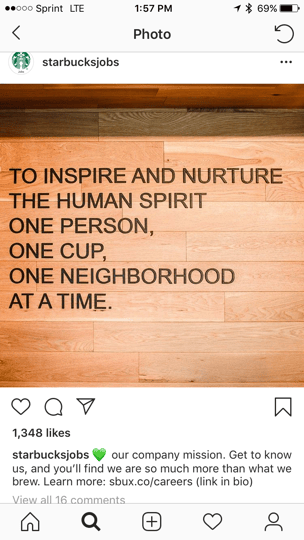
2. HubSpot
HubSpot’s Culture Page features something called the Culture Code, which publicly shares every vision and value HubSpot hopes to promote and instill in employees, candidates, and customers.
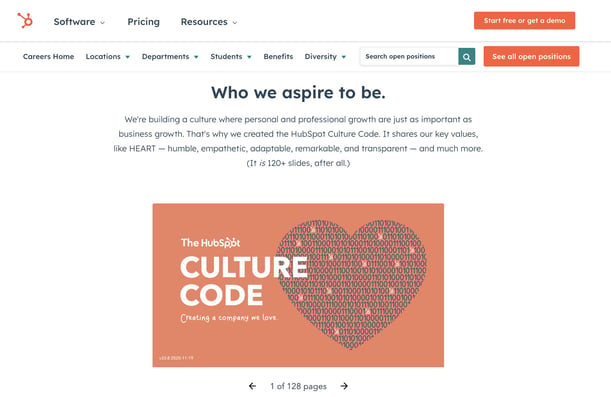
Further down the page, you’ll learn more about opportunities for learning and development, HubSpot’s commitment to diversity and inclusion, and insight and reviews from real employees. The language also consistently focuses on the job seeker: “Picture yourself at HubSpot.”
3. Wistia
For consumers, Wistia brands itself as a video marketing software that helps grow audiences and build brands. It only makes sense that it would be brand-conscious and use its software to underscore the ideas they want to convey to job seekers.
Rather than brag about how great a workplace they are, the first message on its Careers page encourages job candidates: “We’ve got big plans — and they include you!” They continue to underscore that idea with multiple videos about the people who make up the company and the culture they instill.
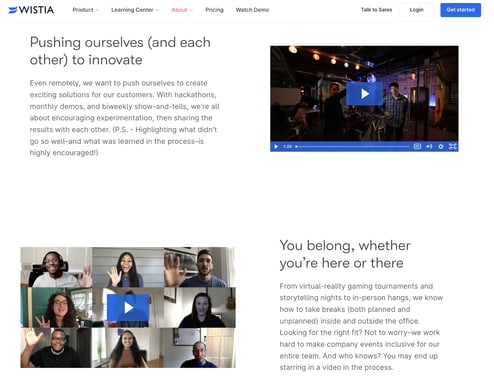
4. SoulCycle
SoulCycle aims to transform traditional corporate culture by offering benefits that evoke a sense of purpose and belonging to each employee.
For instance, Soul gives its employees two paid business days off per year to volunteer at a charity of their choice with the hope that the charity days will help employees feel happy and more fulfilled. Additionally, employees can take classes for free at any time that suits their schedule. This displays Soul’s deeper commitment to making fitness fun and using exercise to de-stress and connect with the community.
With high ratings on Indeed, SoulCycle has undoubtedly cultivated a strong employer brand.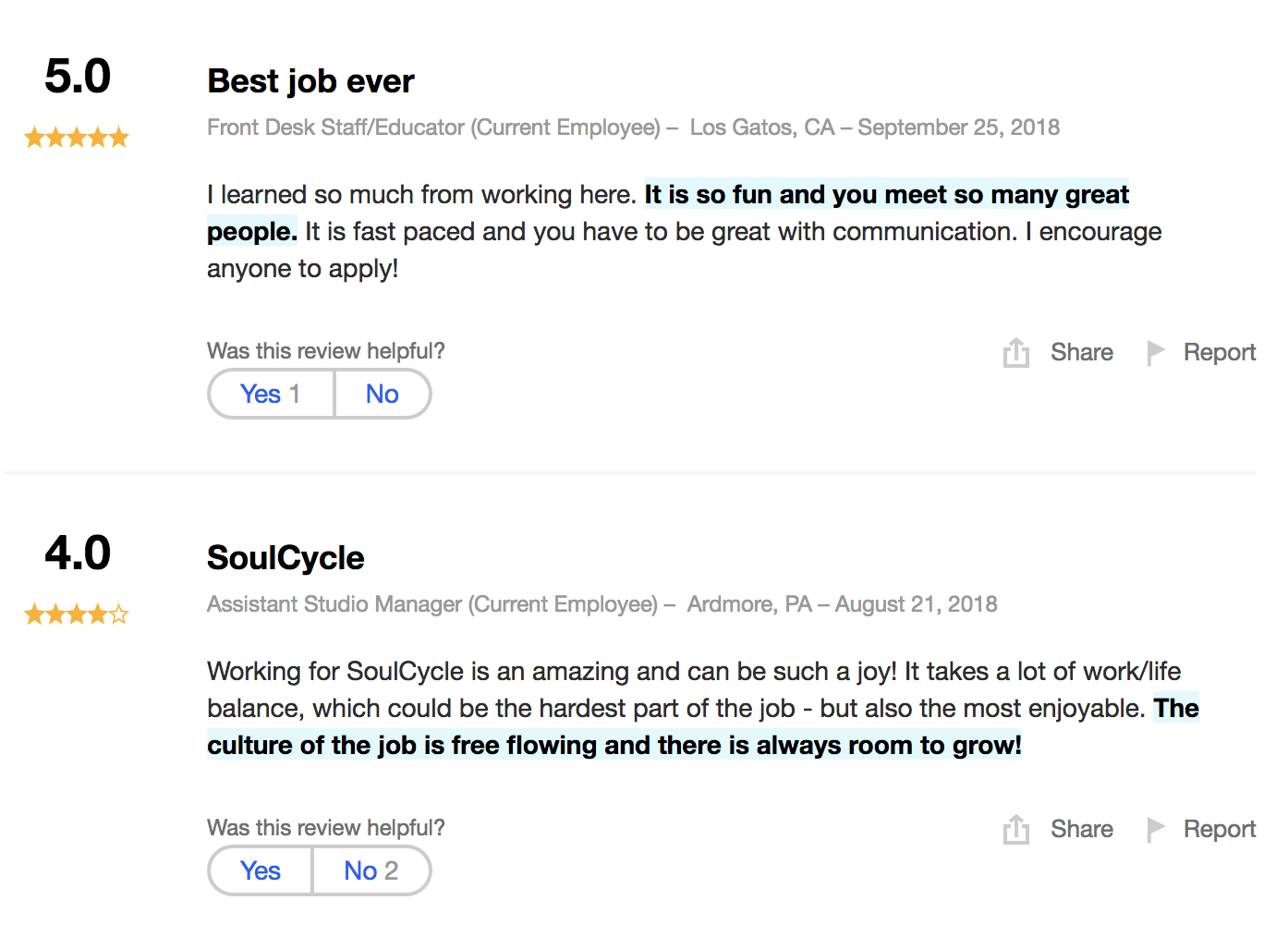
5. Canva
Canva’s employer brand stands out because of its commitment to its mission. Its Careers page highlights its values for job seekers in an interactive carousel and pairs each value with key facts, underscoring the idea that design can be a force for good.
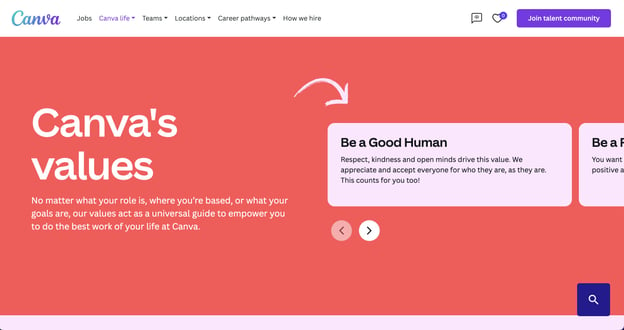
Canva also doubles down on this idea on its social media channels, which are full of inspirational content and ideas furthered by design.
6. Eventbrite
To demonstrate its commitment to recruiting high-quality talent, Eventbrite created a web page to introduce job seekers to its recruitment team. The bios are funny and relatable with fun facts about each recruiter.
Additionally, the Eventbrite recruitment team page states, “Interviewing shouldn’t be nerve-wracking —– it should be exciting. It should spark great conversation. We believe in respect, transparency, and timely responses (we don’t leave anyone in the dreaded recruiting black hole).”
Its language reflects their values, likely inspiring job seekers to apply.
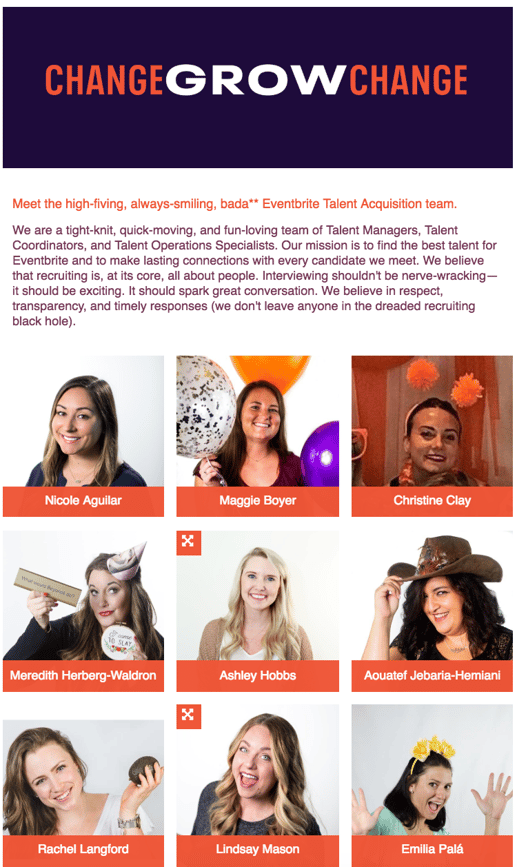
7. Jet
The ecommerce site Jet created this inspirational, employee-focused video to spread awareness for its fun, engaging, motivational workplace. The video is especially powerful because it uses real employee interviews, giving the job seeker a sense for Jet’s work culture and values.
Additionally, the video is likely empowering and pride-evoking for current employees, who can see their company’s clear commitment to carrying out its mission statement through videos of its workers.
8. Shopify
It can be challenging to find qualified applications to fill tech jobs. For many companies, their leverage is having an incredible employer brand and great perks to attract top talent. Companies can take a cue from Shopify, where it recognizes this and tell job seekers that it’s its turn to apply to you.
This acknowledgment is one step toward earning rapport with a potential candidate, and they continue to empathize with the reader by stating that finding the right job and fit is hard work. The rest of its careers page provides all the information someone would need to take a chance and apply to Shopify.
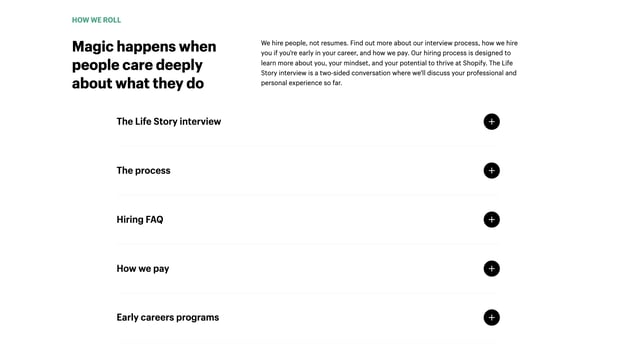
Each one of the examples on this list has in some way shown their empathy, a human element, and a slice of their culture to begin attracting great employees. Human capital is your biggest investment and asset, but remember that your candidates are also investing in you.



